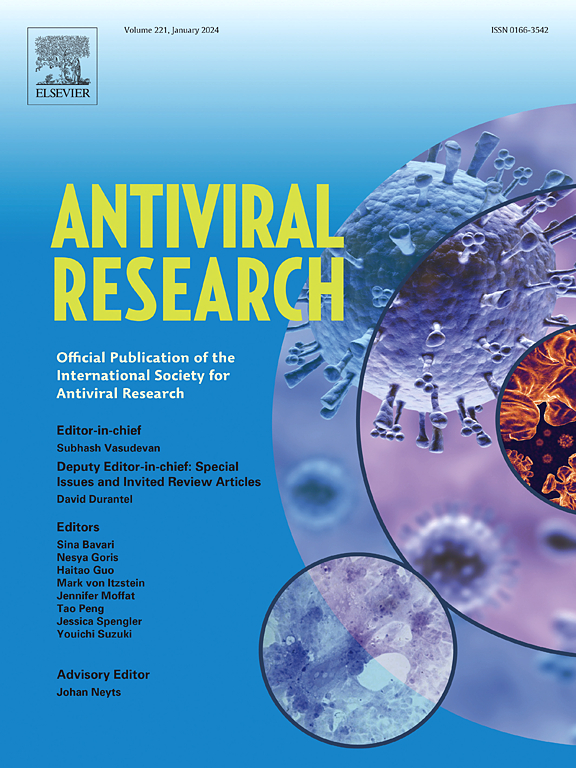Analysis of mechanisms of the rabies virus P protein-nucleocapsid interaction using engineered N-protein peptides and potential applications in antivirals design
IF 4.5
2区 医学
Q1 PHARMACOLOGY & PHARMACY
引用次数: 0
Abstract
The Phosphoprotein (P protein) of the rabies virus has multiple roles in virus replication. A critical function is to act as a cofactor in genome replication and mRNA production through binding via its N-terminal region to the L protein, the essential enzyme for mRNA and genome synthesis/processing, and via its C-terminal domain (PCTD) to the N protein and viral RNA (N-RNA) ribonucleoprotein complex. The binding site of the PCTD on the N protein is a disordered loop that is expected to be phosphorylated at Ser389. This interface may provide novel targets for antiviral approaches. Following an alanine scan of the peptide we selected two single site mutations that showed improved affinity and combined these mutations with a phosphomimetic (S389E) to produce double and triple mutants in the context of linear and cyclic peptides of the disordered loop, with the goal of generating a competitive peptide against the N-RNA complex. To assess the binding properties of the peptides we characterized their thermodynamics identifying complex properties of improved enthalpy but with compensating entropy for mutants and cyclized peptides. Nevertheless, a triple mutant shows 3.5-fold stronger affinity for PCTD than the full-length S389E N protein. Structural characterization of the triple mutant suggests the improved affinity may be due to trapping a favoured β-strand structure for binding to the PCTD. This novel peptide may serve as a template for the future design of antivirals.
利用工程化n蛋白肽分析狂犬病毒P蛋白-核衣壳相互作用机制及其在抗病毒药物设计中的潜在应用
狂犬病毒的磷蛋白(P蛋白)在病毒复制过程中具有多种作用。一个关键的功能是通过其N端区域结合到L蛋白(mRNA和基因组合成/加工的必需酶),并通过其c端结构域(PCTD)结合到N蛋白和病毒RNA (N-RNA)核糖核蛋白复合物,从而在基因组复制和mRNA产生中充当辅助因子。PCTD在N蛋白上的结合位点是一个无序环,预计会在Ser389位点磷酸化。该界面可能为抗病毒方法提供新的靶点。在对肽进行丙氨酸扫描后,我们选择了两个具有改善亲和力的单位点突变,并将这些突变与拟磷基因(S389E)结合,在无序环的线性肽和环状肽的背景下产生双突变和三突变,目的是产生与N-RNA复合物竞争的肽。为了评估肽的结合特性,我们表征了它们的热力学特性,确定了改进焓的复杂特性,但对突变体和环化肽具有补偿熵。然而,三突变体对PCTD的亲和力比全长s389en蛋白强3.5倍。三重突变体的结构特征表明,亲和性的提高可能是由于捕获了与PCTD结合的有利β链结构。这种新型肽可以作为未来抗病毒药物设计的模板。
本文章由计算机程序翻译,如有差异,请以英文原文为准。
求助全文
约1分钟内获得全文
求助全文
来源期刊

Antiviral research
医学-病毒学
CiteScore
17.10
自引率
3.90%
发文量
157
审稿时长
34 days
期刊介绍:
Antiviral Research is a journal that focuses on various aspects of controlling viral infections in both humans and animals. It is a platform for publishing research reports, short communications, review articles, and commentaries. The journal covers a wide range of topics including antiviral drugs, antibodies, and host-response modifiers. These topics encompass their synthesis, in vitro and in vivo testing, as well as mechanisms of action. Additionally, the journal also publishes studies on the development of new or improved vaccines against viral infections in humans. It delves into assessing the safety of drugs and vaccines, tracking the evolution of drug or vaccine-resistant viruses, and developing effective countermeasures. Another area of interest includes the identification and validation of new drug targets. The journal further explores laboratory animal models of viral diseases, investigates the pathogenesis of viral diseases, and examines the mechanisms by which viruses avoid host immune responses.
 求助内容:
求助内容: 应助结果提醒方式:
应助结果提醒方式:


